How to Make Water Kefir
Water kefir is a delicious and easy-to-make probiotic drink that you can make yourself at home. I find this to be a very inexpensive way to culture your own probiotics. Just make them yourself from a live culture – like water kefir – and use the living culture to repeat the process over and over.
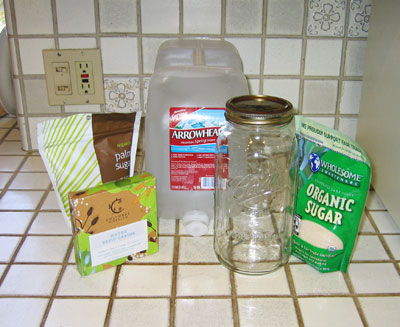
Ingredients you will need to make your own water kefir: dehydrated kefir grains, palm sugar, spring water, 2 qt mason jar and organic cane sugar.
Most of the websites that show how to make water kefir either sell the hydrated, living kefir grains from their websites or advise that you obtain the kefir grains from someone else who has a growing culture and can spare some kefir grains that have multiplied.
In this article, I will show you a different way. You can buy your own dehydrated water kefir grains on the Internet and then rehydrate them yourself. Rehydrating kefir grains will take just a few days and, following that, you can make regular, running batches of water kefir from them.
Kefir Grains
Kefir grains are a culture of bacteria and yeast similar to yogurt or milk kefir. They have a gelatinous texture and a translucent color. Kefir grains tend to multiply after making batches of water kefir. They consume sugar and give off carbon dioxide gas in the process (CO2). The CO2 becomes infused into the water kefir, carbonating it in the process. The fermentation process also creates a small amount of alcohol (less than 1%).
Kefir grains need care and attention, though. They don’t like chlorine and don’t do well when they come into contact with metal. Always use plastic utensils and a plastic strainer when rinsing them. Use bottled spring water (not distilled water). The kefir grains need some mineral content to properly grow. That’s the reason to use bottled spring water. I even rinse the kefir grains with bottled spring water after each batch of water kefir.
Kefir grains tend to grow best at room temperature. If stored in the refrigerator, their growth will slow down. Never store kefir grains outside sugar water, otherwise they can starve and die. Always make sure they have a fresh supply of sugar and fresh water.
Kefir water should culture at room temperature in 24 to 48 hours. After that time, the kefir grains should be rinsed with fresh spring water and a new batch started. If you want to store them for awhile, keep them in the refrigerator in a jar of spring water with sugar for up to a week, but no more, then rinse them and give them some fresh water and sugar.
If properly cared for, the kefir grains can be used over and over, indefinitely in batch after batch of water kefir.
Part I – Rehydrate Kefir Grains
I bought my dehydrated kefir grains from Amazon.com, but you can just as well buy them directly from the supplier. The product is available from the Cultures For Health website. They even offer a “starter kit” complete with an assortment of plastic strainers (http://www.culturesforhealth.com/water-kefir-starter-kit.html). I would go for the starter kit because it is reasonably priced and it can sometimes be hard to find a plastic strainer from a local store.
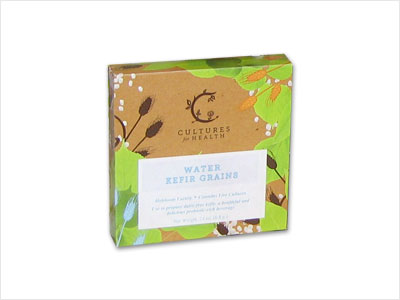
When you rehydrate kefir grains from the Cultures For Health packet, the instructions say to add 4 to 6 tbsp of sugar to 4 cups of water, stir until sugar is dissolved and then add the kefir grains. Wait for 3 to 4 days to allow the grains to plump up and then make the water kefir according to the recipe. In the photo below I am adding 5 tbsp of organic cane sugar to 4 cups of spring water.
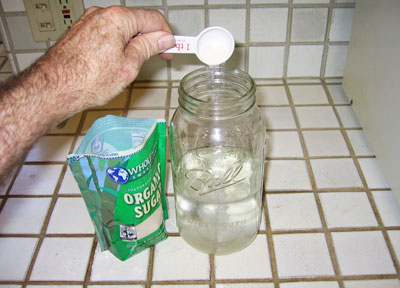
Stir thoroughly to dissolve the sugar …
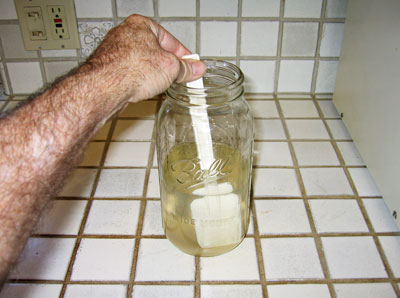 Empty the contents of the packet into the jar …
Empty the contents of the packet into the jar …
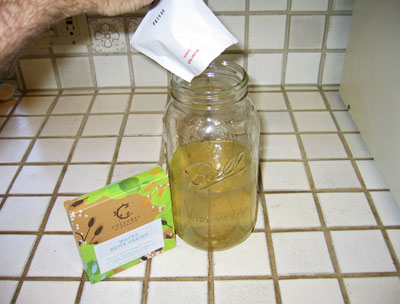 Place a folded paper towel, napkin or paper coffee filter over the top of the jar and secure it with a rubber band to keep out insects while the kefir grains rehydrate.
Place a folded paper towel, napkin or paper coffee filter over the top of the jar and secure it with a rubber band to keep out insects while the kefir grains rehydrate.
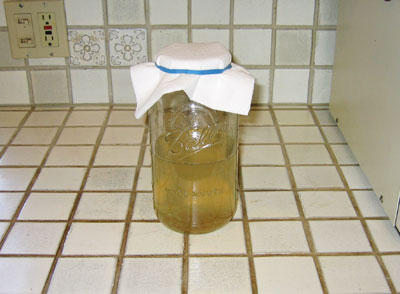
Shown below is a photo of the jar three days later. The kefir grains are plump and fully reydrated. Notice that the color of the water is lighter. That is because the kefir culture has consumed most of the sugar in the process. You can also taste the water after rehydrating. It should be slightly tangy and less sweet than it was at the start. These are both signs of a healthy, active culture.
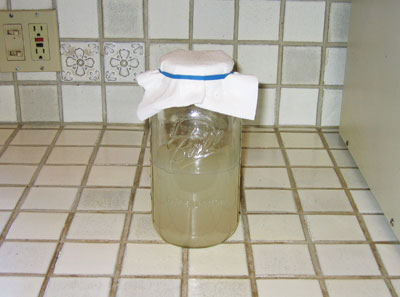 Strain the kefir grains into a bowl with a plastic strainer.
Strain the kefir grains into a bowl with a plastic strainer.
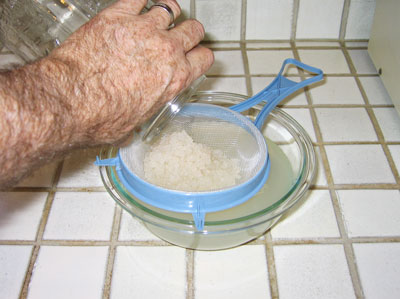 Shown below are the strained, rehydrated kefir grains ready to make water kefir.
Shown below are the strained, rehydrated kefir grains ready to make water kefir.
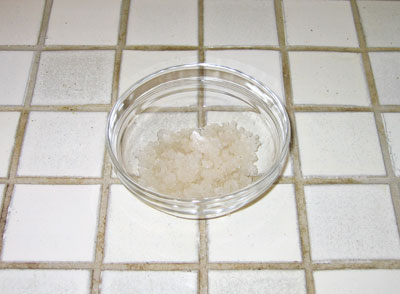
Part II – Making Water Kefir
The following recipe for making water kefir – adapted from GreenMomZoe.
Basic Formula:
- 1 tbsp sugar
- 1 tbsp kefir grains
- 1 cup water
- some dried fruit
Working Recipe:
- 6 tbsp kefir grains
- 6 cups water
- 4 tbsp organic cane sugar
- 2 tbsp palm sugar
- 3 sun-dried unsulfured dried apricots
- 1 sun-dried unsulfured dried Calimyrna fig
Equipment Needed:
- 2 qt mason jar with plastic lid
- plastic strainer
- plastic measuring spoons
- plastic spatula
Start by bringing together all the ingredients. You need a 2 qt Mason jar with 6 cups of bottled spring water, kefir grains, organic cane sugar, coconut palm sugar, sun dried, unsulfured apricots and sun dried, unsulfured Calimyrna figs. All of the ingredients are available from you local health food store.
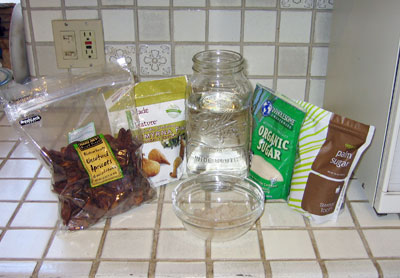
Ingredients: Sun dried unsulfured apricots and figs, Mason jar with 6 cups of bottled spring water, organic cane sugar, palm sugar, kefir grains.
Shown below is the Mason jar with 6 cups of spring water.
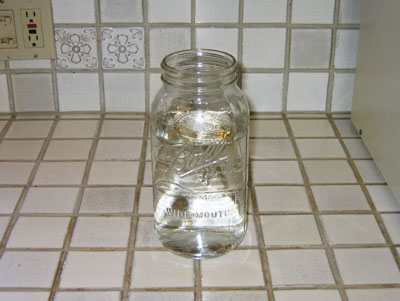 Add 4 tbsp organic cane sugar. Note: Use plastic measuring spoon.
Add 4 tbsp organic cane sugar. Note: Use plastic measuring spoon.
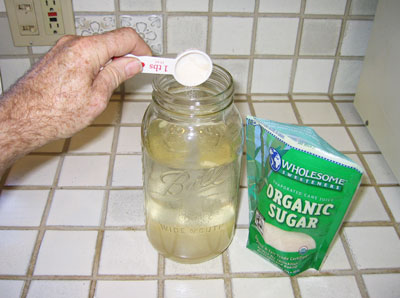 Next, add 2 tbsp palm sugar.
Next, add 2 tbsp palm sugar.
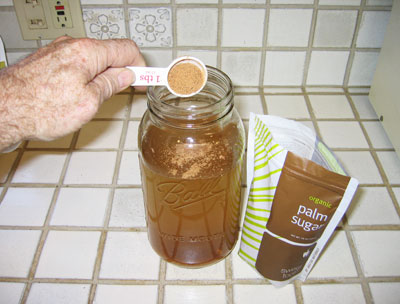 Stir thoroughly to dissolve the sugar. Note: Use a plastic spatula.
Stir thoroughly to dissolve the sugar. Note: Use a plastic spatula.
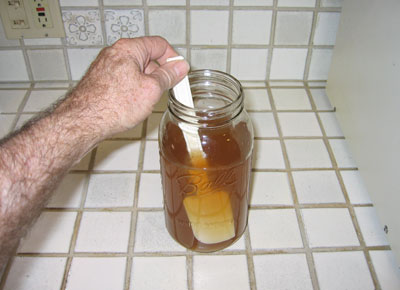 Add the kefir grains.
Add the kefir grains.
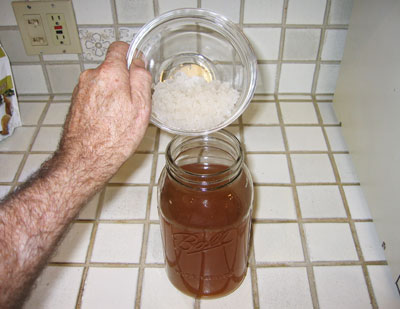 Then add 3 dried apricot halves and 1 Calimyrna fig.
Then add 3 dried apricot halves and 1 Calimyrna fig.
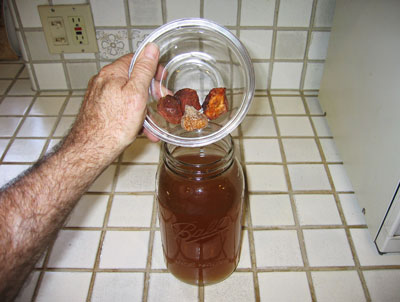 Cover with a folded paper towel, napkin or paper coffee filter and secure with a rubber band to keep the insects out.
Cover with a folded paper towel, napkin or paper coffee filter and secure with a rubber band to keep the insects out.
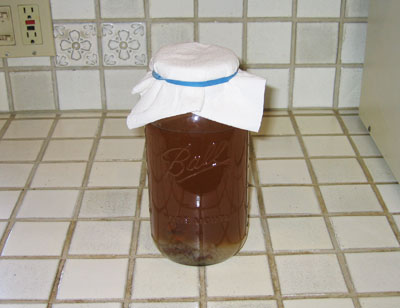
Shown below is the finished water kefir after 2 days (48 hours). The fermentation process could take between 24 and 48 hours depending on the conditions. You may find that after a few batches, some batches will be done in 48 hours, some in 36 hours and perhaps some will be done after 24 hours.
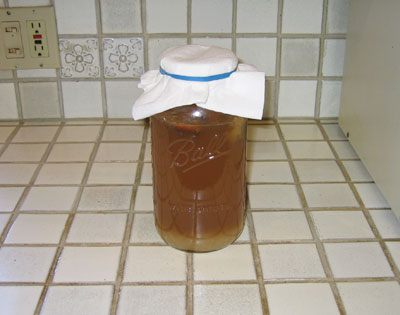 Get a bowl and a plastic strainer.
Get a bowl and a plastic strainer.
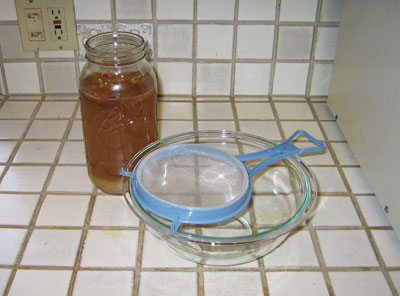 Empty the contents of the jar to strain everything. Separate the fruit from the kefir grains and discard.
Empty the contents of the jar to strain everything. Separate the fruit from the kefir grains and discard.
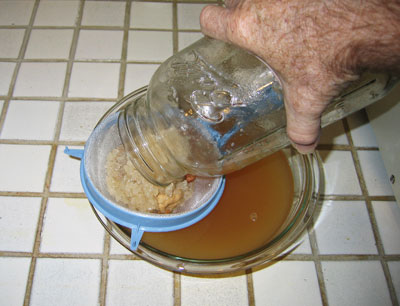 Pour the strained water kefir into a clean Mason jar and close with a plastic lid. Plastic lids are available for Mason jars. Store in the refrigerator.
Pour the strained water kefir into a clean Mason jar and close with a plastic lid. Plastic lids are available for Mason jars. Store in the refrigerator.
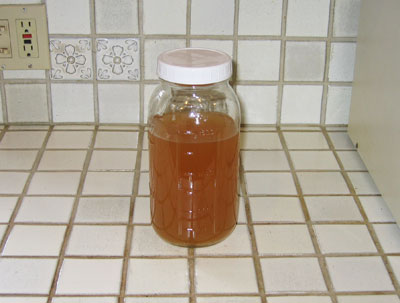 Meanwhile, rinse the kefir grains after separating the spent fruit. Use bottled spring water to rinse them.
Meanwhile, rinse the kefir grains after separating the spent fruit. Use bottled spring water to rinse them.
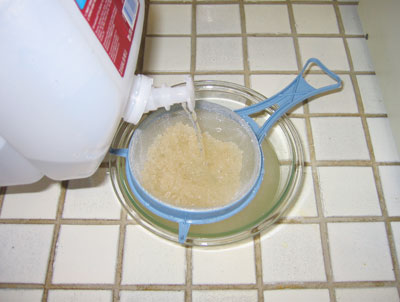 Shown below are the rinsed kefir grains ready for the next batch of water kefir. Repeat the previous steps to make the next batch.
Shown below are the rinsed kefir grains ready for the next batch of water kefir. Repeat the previous steps to make the next batch.
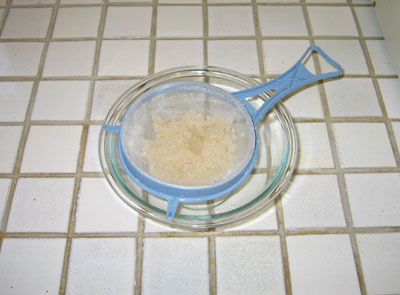
I want to get water kefir grains.I live in Baghdad,Iraq.
Can you order from Amazon.com? If so, you can get it here: http://www.amazon.com/Water-Kefir-Grains-BONUS-Premium/dp/B00ICPWY6S/ref=sr_1_15?ie=UTF8&qid=1396644041&sr=8-15&keywords=water+kefir+grains. Here a re a few more at Amazon: http://www.amazon.com/s/?ie=UTF8&keywords=water+kefir+grains&tag=googhydr-20&index=aps&hvadid=34088430671&hvpos=1t1&hvexid=&hvnetw=g&hvrand=4566167981817706106&hvpone=&hvptwo=&hvqmt=b&hvdev=c&ref=pd_sl_3bqs1v782i_b